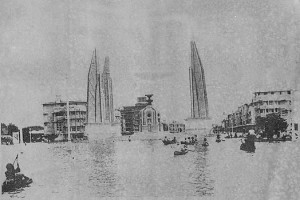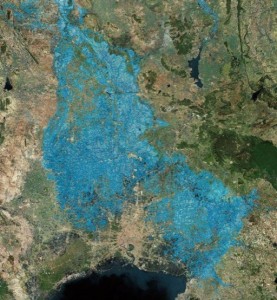For those that don’t know Thai, the title of this post is a nod to the fact that central Bangkok is about the only place within a few hundred kilometers that isn’t covered in 10 feet of water. Koh in Thai means island, and Krung Thep (กรุงเทพ) is the Thai name for Bangkok, a little island humor, haha…yeah. Anyway, I figured I’d be remiss if I didn’t post something about the flooding that’s causing so much destruction. Despite millions of sand bags, kilometers of sluice gates and floodwalls, and thousands of army troops working their camouflaged asses off, much of central Thailand is underwater. As the crisis reached its peak a few days ago, there seemed to be more and more people that were blaming either a) Mother Nature, b) the Government, or c) Ourselves. One can understand some fierce sniping at the government (more on that later) but really…everyone kind of knows that we brought much of it on ourselves.
In his great weekly columns in the Bangkok Post, Voranai Vanijaka holds up a no-nonsense mirror to Thailand and its foibles, and this week is no different.
“Given climate change, deforestation, decades of poor planning and mismanagement, the flood disaster will get progressively worse and worse. The present disaster will pale compared to the next one.”
Yes, Thailand is a country regularly affected by monsoon rains and yes, this year has been much heavier than usual, but the cries that rampant stripping of forests to build resorts, filling in of canals that act as drainage pathways, and officials looking the other way for the right price are – to my ears, anyway – becoming louder and louder. As Bangkok Post writer and Tweeter @terryfrd said:
“Suspect the post-mortem on flood causes is going to be ugly. Nothing was ready. Hope it is objective & not just a series of recriminations.”
So that’s one aspect of the reactions. From my experiences, many in Thailand don’t really have a solid grip on the whole “cause and effect” concept yet; immediate gains take precedence over long-term ones. Granted, great strides have been made over the past few decades in terms of new drainage canals and various engineering projects to help alleviate some of the effects caused by harsh seasonal weather conditions, but they don’t seem to be able to keep pace with development, not to mention global climate change.
One can also not just blame “The Government”. Support the current administration or not, the lack of preparation and proper flood management infrastructure are the fault of all the governments going back about 50 or 60 years since modern technology and infrastructure began to spread throughout the country. As I mentioned above, some work has been done to help, but clearly not enough.
However, one can blame the current government for a genuine lack of coordination. One minister says this, another says that, one says “Run!” the other one says “No need to run!” People are confused, scared, and tired of not knowing what’s going on. But we can’t expect anyone to be omnipotent when it comes to knowing how a billion cubic meters of water will act; all we can is wait.
One idea, proposed by Science and Technology Minister Plodprasop Suraswadi, involved a thousand tug boats tied to a bridge, running at full throttle to ‘push’ the water out into the ocean, thereby draining upriver water faster. My buddy Gordon has a great Flickr set of the tugboats in, uh… action.
Most people were skeptical of the plan – a thousand propellers against billions of cubic meters of water doesn’t seem like it would have any effect; it would be like trying to generate enough lift for an airplane to take off by holding a living room fan in front of it. The ratios of mass are just too incongruent.
Twitter user @steadirob – whom I’ve never met and have no idea of his credentials – tweeted this:
A fluid cannot be compressed; it will find the way of least resistance which – in a river – is up. Locally raising the level to increase flow you need a massive wall, like a piston in a cylinder, to push ALL the water forward, not just surface. Even then you can only very slowly increase speed because you need to move miles downstream. As that is impossible, the result is again that the water level downstream of pushing will go UP, resulting in even more flooding.
Most of that sounds feasible. My buddy Jon also posted the question on Quora and got some solid information from a few interesting posts, but to really cut to the chase, I did something that no one else seems to have done yet, at least not in the English press that I’ve seen – ask an actual scientist. I sent an email to (deep breath) David R. Williams, Professor of Mechanical and Aerospace Engineering and Director of the Fluid Dynamics Research Center at the Illinois Institute of Technology. I linked to the above Bangkok Post article, and this is what he wrote back:
Hi Greg
It seems possible to me, but it depends on the thrust produced by the boats, the flow rate through the river, the cross-sectional area of the river, etc. The numbers quoted in the article are not really defined, but a 20%
D. Williams
Interesting… so maybe it does have an effect? I’m skeptical as well – given the flow rate, comparatively low thrust rate of the boats, and the sheer mass of water coming down the (very deep) Chao Phraya River, it seems to me just a waste of fuel, but hey, who am I to argue with science?
What do you think?








Greg, last week I asked a scientist and this was his reply: I doubt that 1000 boats will do anything more than increase the surface velocity slightly for more than 2 – 3 m behind the propellors. The best part of the plan is that they will have 1000 boats on hand to rescue the people caught in a flood they don't prevent!
Good breakdown Greg. Nice comparison pic with the airplane
We had a lovely flood in Bangkok back in 1995 also, I remembered fishing at my pak soi.
I'm a bit skeptical of the tug boat plan, it might help pushing water to go faster on the surface, but might slow down the tide underneath the surface. But I slept all the way through Fluid Dynamics in my university days, so I'm not going to against this Konami-code-enabled plan.
I know, um, well, dick about anything scientific at all, but I think the words "tug boat" tell us everything we need to know about the level of government planning and scientific knowledge being brought to bear on this situation.
However, on the off-chance I am wrong, I have dipped into my private fortune and have distributed 10,000 boogie boards to the kids who swim in the canals so they can kick furiously in rows of 50 at strategically placed run-off points.